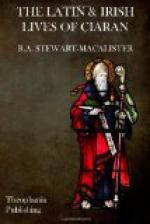XLVII. HOW CIARAN WAS SAVED FROM SHAME (LB)
Contemporary representations (e.g. on the sculptured crosses) show that at this time two garments were normally worn, a lene or inner tunic, and a bratt or mantle. These, with the addition of a cape, something like a university hood, which could be thrown over the head, made up the complete equipment, and if all these were given to beggars the owner would be left completely destitute. So, in the story of the Battle of Carn Conaill, as narrated in the Book of the Dun Cow, Guaire, king of Connacht, of whom we have already heard, on one occasion would, if permitted, have divested himself of all clothing to satisfy importunate beggars. The device of the water-covering is remarkable.
XLVIII. HOW A MAN WAS SAVED FROM ROBBERS (LB)
This story, summarily and rather obscurely told in the text before us, is related more clearly in the Life of Brenainn (VSH, i, 101). The saint, seeing a man hard pressed by his enemies, bade him take up his position beside a standing stone; he then transformed the victim into the stone, and the stone into the victim. The assailants, thus deceived, cut off the head of the stone, and departed in triumph: the saint then reversed the transformation, leaving the man to go his way in peace. An analogous story is that of Cadoc, who turned raided cattle into bundles of fern, and transformed them back to cattle when the raiders had retired discomfited (Cambro-British Saints, pp. 49, 342).
XLIX. THE DEATH OF CIARAN (LA, LB, VG)
This impressive story, which is as remote as possible in style from the ordinary stock incident, is probably authentic. The chronological indications in VG are quite wrong: the 9th of September A.D. 548 was a Wednesday, and was the twentieth day of the moon. They are, however, so far accurate for the year 556, that 9th September in that year was Saturday, and was the nineteenth day of the moon. As the observation of new moon, if not astronomically calculated, is often wrong by a day, owing to the faint crescent not being seen at its very first appearance, this is sufficiently close to allow us to enquire legitimately whether 556 may not have been the true date of Ciaran’s death.
The Bollandists cite from the Life of Saint Cellach a tale to the effect that Cellach was son of Eogan Bel King of Connacht, and was a monk at Clonmacnois; but on the death of his father he secretly absconded, in order to secure the kingdom for himself. Becoming convinced of the sinfulness of this proceeding, he returned and submitted to Ciaran once more, who received him fraternally after he had spent a year in penance. As the Bollandists point out, this story (quite independently of its historical authenticity) reveals a tradition




